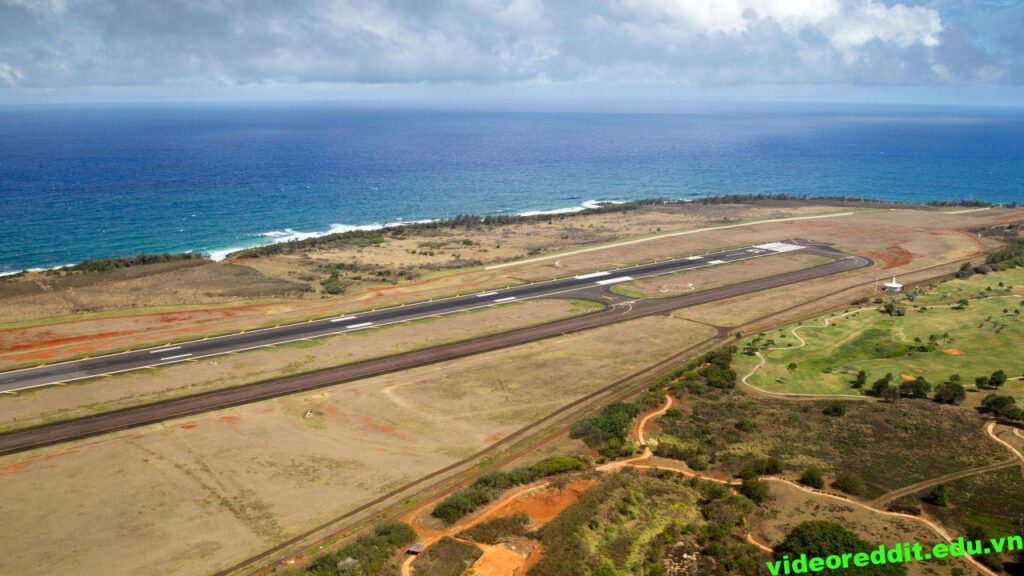
On April 11, 2024, Southwest Flight 2786 plunged towards the ocean near the Hawaiian Islands in a heartbreaking incident that has only recently come to light. The case has now been referred to federal authorities for investigation – a development that is causing widespread commotion regarding aviation safety. Given that the plane was only 400 feet away from crashing into the ocean, it will be relevant to find out what really happened and how a potential disaster was averted. The article will delve deeply into the incident, discuss the possible contributing factors that may have caused the plane to plummet so low, and consider the response and actions taken by the pilots and aviation authorities.
I. The Harrowing Descent of Southwest Flight 2786: A Timeline of Events
This morning, Southwest Flight 2786 was flying a routine Boeing 737 MAX 8 inter-island flight from Honolulu International Airport to Lihue Airport on the neighboring island of Kauai. As the plane approached its destination, bad weather began. Here’s a timeline of the key events that unfolded:

A. Approach and Landing: As the flight neared Lihue Airport, the pilots encountered adverse weather conditions, including lower than normal visibility and possible turbulence. They began the approach and landing on track feeling confident, but when the plane began to descend, things went from bad to worse.
B. Uncontrolled Descent and Rapid Loss of Altitude: At an altitude of about 6,000 feet, the aircraft suddenly entered an uncontrolled descent, falling at more than 4,000 feet per minute. The rapid loss of altitude disturbed the pilots and caused distress. The aircraft continued to dive towards the sea, with the pilots struggling to regain control.
C. Pilots’ response and recovery: Faced with a precarious situation, the pilots acted immediately to abort the landing and avert potential disaster. Reports indicate that the first officer—who had less experience with the Boeing 737 MAX 8—may have pushed too far forward on the control column; the plane suddenly went into a rapid downward slide. But the pilots’ presence of mind spelled salvation that day.

D. Successful recovery and return to Honolulu: The pilots were able to regain control of their aircraft and abort the landing due to their quick reflexes and effective reaction. The aircraft climbed rapidly to avoid a possible crash into the ocean. After this, the pilots wisely decided to abort the landing at Lihue and return to the main Honolulu airport to ensure the safety of the passengers and crew.
II. Factor analysis: understanding what went wrong
A mix of factors may have contributed to Southwest Flight 2786’s runway landing: weather conditions, pilot experience, and a possible malfunction of aircraft systems. Here’s a detailed look at the key factors that may have caused this accident:

A. Adverse Weather Conditions: In addition, the weather at Lihue Airport was troublesome for the aircraft’s approach, including poor visibility and possible turbulence. All of these conditions could have affected the pilot’s ability to safely navigate and maintain control of the aircraft during the critical phase of the aircraft’s flight – the descent.
B. Pilot experience and training: Reports suggest that the first officer at the controls was less familiar with the Boeing 737 MAX 8. Thus it can be assumed that unfamiliarity with this particular type and its unique flight characteristics may have led to an uncontrolled descent. Experience and training are very important for managing emergency situations and increasing situational awareness.

C. Possible aircraft system malfunction: This event may have been caused by aircraft system malfunction or failed equipment. For example, faulty sensors may have provided incorrect information or erroneous flight data to the pilots, causing them to make incorrect control inputs and then enter an uncontrolled descent phase.
III. Response and action tasks: ensuring safety and prevention of further incidents
How pilots, aviation authorities and airlines respond and act after the incident is very important to ensure safety and prevention in the future. Here is an overview:

A. Quick thinking and corrective action by the pilots: However, congratulations to the pilots of Southwest Flight 2786 for their quick, efficient response to the emergency. Corrective action was taken in time to avert imminent disaster – immediately regaining control and beginning a steep climb. Undoubtedly, their training and professionalism played a huge role in the recovery.
B. Federal Aviation Administration Investigation: At that time, the controlling authority for aviation safety in the United States, the FAA, launched an immediate investigation into the incident. The FAA inquiry will include examining flight data, cockpit voice recorders, and interviewing the pilots and other relevant personnel. It is expected that all stakeholders will be asked to determine what caused the uncontrolled descent, along with taking necessary safety measures so that this type of incident does not happen again.
C. How Southwest Airlines responded: Southwest Airlines, the company operating the flight, acknowledged the incident and reaffirmed its commitment to safety. The statement noted the existence of an active SMS and efforts to improve it. Southwest is fully cooperating with the FAA investigation, but will apparently conduct its own internal review to take measures and improve safety and procedures.
IV. Lessons learned and preventive measures: enhancing aviation safety
The case of Southwest Flight 2786 brings many lessons and once again highlights the fact that aviation safety is an ongoing process. Some of the key lessons learned and preventive measures to promote safety are as follows:
A. Focus on pilot training and experience: This incident again underlines the importance of pilot training and experience. Ensuring that pilots are adequately familiar with the aircraft they are flying, and giving them good training on various aircraft systems and emergency procedures can facilitate better operations when such a situation arises.
B. Improve reliability in aircraft systems: Malfunctions point to the fact that aircraft must have reliable and fail-safe systems. Aviation authorities and manufacturers need to make more efforts to develop reliable aircraft systems, from sensors to flight control systems to warning mechanisms. Redundancy and backup systems can prevent the consequences of potential malfunctions.
C. Creating a fair culture of safety reporting: Prompt incident reporting by pilots and subsequent investigation by the FAA serve as indicators of a strong safety culture in aviation. Promoting an open and honest reporting culture for safety – handling incidents and near-incidents efficiently – is really important to uncover and correct potential shortcomings in safety.
V. Conclusion: Reflections on Narrow Escapes and Looking Ahead
The Southwest Flight 2786 incident reminds us of the challenges and potential dangers a pilot can face, as well as the importance of training and presence of mind. Although the recovery of the aircraft and safe return to Honolulu was commendable, I need to learn from this near-miss and put in place practices that will prevent similar incidents in the future.
As the FAA investigation progresses, it is going to uncover many shocking facts about the various factors that led to this uncontrolled descent. This information will lead to the implementation of better and more appropriate measures that include safety procedures, improved training programs, and perhaps even modifications to aircraft systems. Learning lessons from this experience and taking proactive steps in using such knowledge – by taking measures to reduce the occurrence of such accidents in the future – could make the industry a lot safer.
It is a reminder to pilots to stay alert, situation-aware and prepared for emergencies at all times. For passengers, it is a reminder to them of their trust and confidence in aviation – how it should be better to ensure their safety, not just good.
Reflecting on the near-miss incident of Southwest Flight 2786, the commitment and professionalism of the pilots, the response time taken by aviation regulators in the wake of such incidents, and the efforts made towards improved aviation safety need to be put into perspective. We can achieve safer skies and a more resilient aviation sector through collaboration and experience from each incident.
frequently Asked question:
.What factors, presumably, may have contributed to the uncontrolled descent of Southwest Flight 2786? This uncontrolled descent can be attributed to a mix of factors: adverse weather conditions, pilot experience, and a possible malfunction of the aircraft’s systems. Poor weather conditions, including poor visibility and turbulence, can impair the pilot’s ability to navigate and maintain control. Type unfamiliarity—that is, a lack of experience and knowledge about the type of aircraft in question and its peculiarities—may have contributed to this. Finally, a malfunction of some aircraft systems or a failure of equipment cannot be completely ruled out.
Question 2: How did the pilots react to the emergency, and what actions did they take? Answer: Apart from the uncontrolled fall, the pilots responded promptly and effectively with proper recovery actions. Quick thinking and timely reaction on their part averted a potential disaster. Undoubtedly their training and professionalism played a role in the successful recovery of the aircraft.
Q3: What did the Federal Aviation Administration and Southwest Airlines do after the incident? The FAA launched an immediate investigation into the incident by analyzing flight data and interviewing relevant personnel. This is to determine what exactly went wrong so that appropriate measures can be taken to prevent recurrence of such incidents in the future. Southwest Airlines should conduct the necessary internal review and possibly cooperate with the FAA to ensure that its safety measures are enhanced.
Question 4: What lessons does this incident teach us for improving aviation safety? Incidents like this clearly underscore the critical importance of pilot training and experience. Improved training programs are being worked on, and familiarizing pilots with a greater degree of familiarity with multiple aircraft systems and emergency procedures will help build the ability to respond appropriately in difficult situations. This incident also brings to light the need for both reliable aircraft systems and strong safety-reporting cultures that promptly identify and correct hazards.
- How can the aviation industry ensure that incidents like this do not recur in the near future? This near-miss teaches important lessons for further improvements in aviation safety. With better training, more reliable aircraft systems, and an open and honest culture of safety reporting from pilots, these safer skies can be a goal the industry strives for. Continuous improvement, collaboration, and proactive safety will go a long way toward reducing risks to the traveling public, ensuring that passengers and crew are safe.




